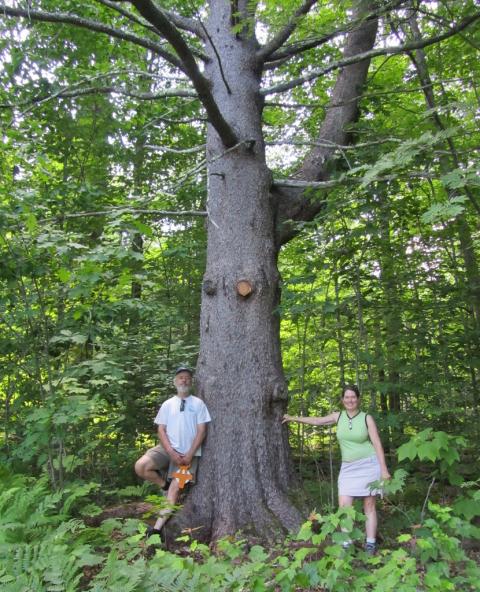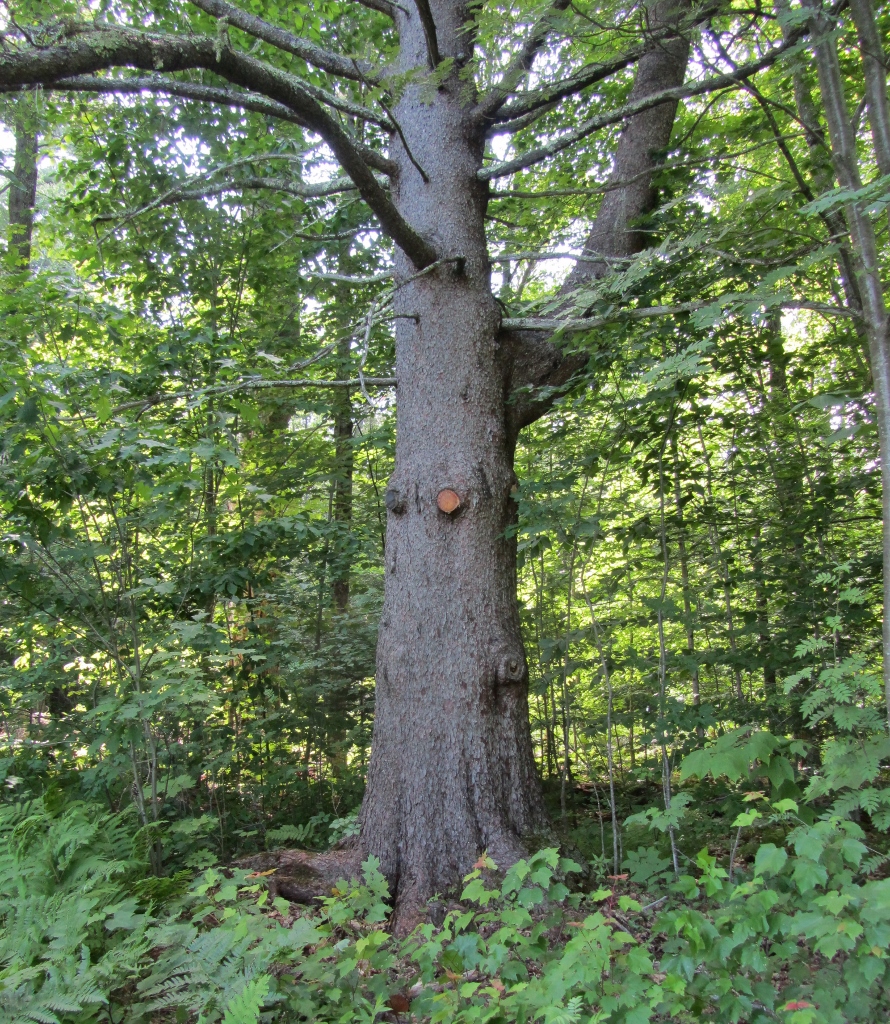The American Larch: "A Stick in the Mud"


American Larch, Tamworth, NH
A major tree of the northern boreal coniferous forest of North America, Tamarack or American Larch (Larix laricina), grows in the northern counties of NH. In southern NH, it grows naturally only in boggy locations, or in landscaping sites where it has been transplanted.
Tamarack is easy to identify in both winter and summer. It is the only deciduous conifer tree in NH. In the fall its needles turn a striking yellow color before they fall, leaving a very twiggy, dead looking silhouette during the winter; usually a straight trunk with upward pointing branches at the top and horizontal branches lower down. Small cones (1/2” – ¾”) that look like little knobs or galls are attached along the top side of branches providing another distinctive winter identification clue – the only tree in winter with cones but no needles. The old, oval cones can remain on the branches for years after releasing their seeds.
Its leaves are needles, so it is classified in the pinaceae family of trees, even though it sheds them in the fall and is obviously not an evergreen tree. This unique adaptation means that it can survive bitter cold and grow further north than any other tree. It is totally dormant during the winter and does not have the problem of protecting needles from the ravages of weather. Its range extends to northern Canada up to the Arctic Circle where temperatures can dip to -65! On the southern edge of its natural range as explained by William Cullina of the New England Wildflower Society in his book Native Trees Shrubs and Vines, “tamarack is relegated to floating bogs where constant evaporation keeps the substrate cool, and extreme acidity limits competition. It is a strange thing to walk out gingerly on a floating mat of sphagnum moss and see larch trees swaying back and forth on the rippling waves created by your footsteps in the water hidden below.” pg. 153. It is the first tree species to invade bogs where the seeds germinate in the sphagnum moss. Its roots eventually drop down through the bog to get to the firm bottom. Although restricted to walking on the board walks and not on the quivering moss, one can see small larch trees growing in this manner at the NH Audubon’s Ponemah Bog in Amherst, NH.
Another adaptation of larch trees that enables them to grow in bogs or anaerobic sites with little oxygen in the soil, is its altered internal chemical properties. From the US Army Corps of Engineers Wetlands Delineation Manual, Appendix Cl: ‘Species that produce high levels of nitrate reductase (e.g. Larix laricina) are adapted for life in anaerobic soil conditions.’
Hillsborough County Champion
American Larch, Nashua NH
In spring, its new needles transform it from winter ugly to spring beauty. The tufts of light green, inch- long needles create a soft, lacy look for the summer. The tree’s regular pyramidal shape and light green color are attractive attributes – it grows to 40 -80 feet and its slender trunk grows to about 1-2 feet in diameter, with scaly, reddish-brown bark.
The oval, winged seeds that are produced in cones about every 4 -6 years are disbursed by the wind in the fall. Mice and voles gobble them up. Any seeds remaining go through the natural winter dormancy process, and the viable seeds will sprout in the spring. Tamarack or larch seeds don’t remain viable for much more that a year in the wild. They will only germinate when they encounter very specific conditions like consistently wet sphagnum moss. This is called its germination niche. Tom Wessels in his fascinating book Reading the Forested Landscape cites the tamarack to explain this idea. Once a larch germinates it can be transplanted and grow in conditions outside its germination niche. “A tamarack can’t germinate in a well-maintained lawn, but a young sapling can be successfully transplanted on one, so that all the tamaracks we see in parks and yards are transplants.” pg 132. One tamarack tree does not indicate its niche; look for groups of trees to show its natural growing habitat.
Not only are its seeds picky where they germinate, they have a tough time getting started. Because the first year seedlings are small, they are easily killed during the first 6 or 8 weeks after germination. The second and third year seedlings can die from drought, drowning, or inadequate light. For best growth, tamarack seedlings need abundant light and a constant but suitable water level.
Apparently it can be difficult for nurseries to get seed; I found this plea for tamarack cones in July 2006 on the Wisconsin Extension Web site:
Tamarack cones wanted, high price paid by state tree nursery
HAYWARD, Wis. – The state tree nursery at Hayward needs seed cones from Tamarack trees. Because of the difficulties in obtaining these cones the nursery is paying $200 a bushel or $6.25 a quart.
The announcement explained that the cones don’t fall and squirrels do not drop them to the ground as they do with other kinds of pine cones. So the only way to get good seed cones from mature trees that have the best viability is to cut the tree down! But there are so many cones on one tree that they are worth more than the wood. The wood is tough and rot resistant, and the tree had a variety of historical uses. The root strings being very tough and fibrous were used by Indians to sew birch bark canoes. The name hackmatack comes from the Algonquain language for snowshoe wood. They also used the bark for medicine.
Ponemah Bog, Amherst, NH
The colonists used larch for ship building. They harvested the roots that had grown right angles to make ‘knees’ to join the ribs to the deck timbers. Today, the rather coarse-grained, hard, heavy and strong wood is used for planking,timbers, railroad ties, fence posts, telephone poles, shipbuilding and turpentine (from its European cousin).
Although not used much in landscaping because of its seasonal needle loss and forlorn winter appearance, UNH Extension Forester Jonathan Nute notes that in the Civil War era and earlier, “it was common to have one in a town cemetery to symbolize ‘death’ in the winter and ‘rebirth”’ in the spring.”
The European Larch (Larix decidua) is used in landscaping – it grows much larger than American larch, and tolerates warmer temperatures, is found further south than native larch. On a spectacular fall drive high in the French Alps near the Italian border, we drove by a forest of huge pine trees that were a sickly yellow color. I thought they were all dying from air pollution. Due to French language limitations I was unable to find out what was wrong. Not until I became a Tree Steward years later, did I realize that these were European larch trees showing their brilliant fall color before dropping the needles for the winter.
If you find a big tamarack/larch tree, especially one in a cemetery where all can see it, go to www.nhbigtrees.org and compare it with the listed NH county champion trees. If its trunk measures as large as those listed and it appears as tall, follow instructions on the site for submitting a nomination. A team of volunteers will officially measure it for consideration. The UNH Cooperative Extension and the NH Division of Forests and Lands sponsor the NH Big Tree program in cooperation with the National Register of Big Trees through American Forests.
About the Author
Anne Krantz admits, “I literally stumbled into the fascinating the Natural Resources Stewards Program and followed that with the comprehensive Master Gardener training.” Participating in a special training in 2009, Anne became part of the first team of volunteers to answer homeowner questions at the Education Center, an activity she continues to love.
“Because of these excellent education opportunities I now serve on my conservation commission, the NH Pesticide Board and the Rivers Management Advisory Council," she says. "I have also enjoyed UNH Extension's Big Tree program; I just found a flowering native chestnut tree this morning!”


